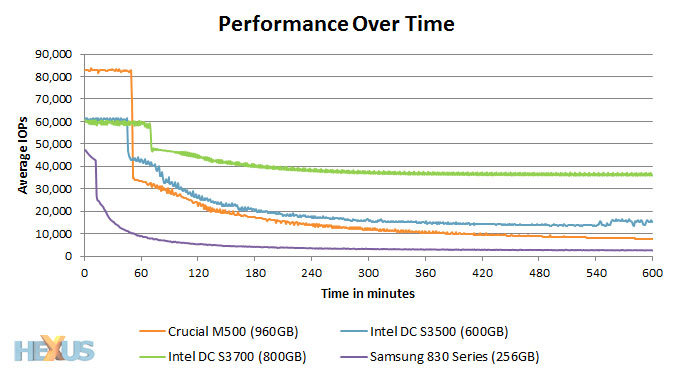Performance Consistency
All of today's benchmarks were carried out on an Intel Ivy Bridge test platform. Though we're primarily pitting the 600GB S3500 against an 800GB S3700, we've also included numbers for a high-capacity 960GB Crucial M500 and a previous-generation 256GB Samsung 830 Series drive to highlight the advantages of enterprise drives over regular consumer solutions.
Intel DC S3500 (600GB) |
Intel DC S3700 (800GB) |
Crucial M500 (960GB) |
Samsung 830 Series (256GB) |
||
|---|---|---|---|---|---|
| ATTO Benchmark | 1MB Read | 483 MB/s |
490 MB/s |
540 MB/s |
547 MB/s |
| 1MB Write | 493 MB/s |
486 MB/s |
439 MB/s |
410 MB/s |
|
| Crystal Disk Mark | 4K QD32 Read | 309 MB/s |
306 MB/s |
342 MB/s |
300 MB/s |
| 4K QD32 Write | 256 MB/s |
245 MB/s |
344 MB/s |
152 MB/s |
|
| AS SSD | Read Score | 373 Points |
370 Points |
406 Points |
359 Points |
| Write Score | 337 Points |
327 Points |
404 Points |
204 Points |
|
| Iometer | 4K Random R/W | 66,724 IOPs |
65,210 IOPs |
61,443 IOPs |
44,529 IOPs |
| PCMark 7 | Importing Pictures | 30.08 MB/s |
30.29 MB/s |
28.13 MB/s |
28.46 MB/s |
| Video Editing | 22.90 MB/s |
23.12 MB/s |
22.93 MB/s |
22.74 MB/s |
|
| Starting Apps | 58.13 MB/s |
60.94 MB/s |
51.59 MB/s |
56.05 MB/s |
|
| Overall Score | 5,399 Marks |
5,445 Marks |
5,263 Marks |
5,271 Marks |
|
Examining various performance characteristics using our conventional SSD benchmark suite doesn't provide a great deal of insight. Indeed, benchmark any of the above drives in a factory-fresh state and what you see are solid performance numbers throughout.
To tell enterprise SSDs apart, we need to stress the drives over longer periods of time with more demanding workloads.

In the above graph, each SSD is subjected to random 4K writes across the entire span of the drive at a queue depth of 32 for a full 10 hours. Bombarding the drives in this manner forces each SSD to run out of the free blocks that initially allow fast write times. The sharp performance drop off is attributed to increased write amplification, as the drives are having to perform read-modify-writes for randomly written data going through garbage collection.
The results are almost perfectly in line with Intel's specification. The 800GB S3700 levels out at just over 35,000 IOPs, while the 600GB S3500 settles in at around 15,000 IOPs.

Examining the average latency throughout the 10-hour 4K write provides a good look at the capabilities of each drive's garbage collection algorithms. As expected, the 600GB S3500 puts in a decent showing but it understandably isn't able to match the excellent performance on offer from the pricier S3700.

Taking a closer look at maximum latency shows us how consistent the drives are. The consumer drives from Samsung and Crucial have a wide scatter, occasionally taking up to 1,000ms or up 300ms, respectively, to respond to a write transaction.
These unwanted delays don't exist on the S3500; it's practically as consistent as the S3700. Both draw a near-perfect line across the bottom of this graph, and this level of consistency is key in enterprise environments, where entire RAID arrays can suffer from performance anomalies in any one drive.









